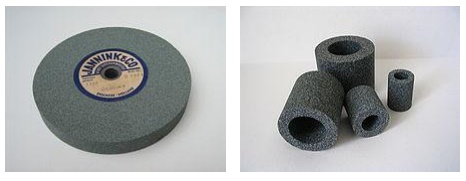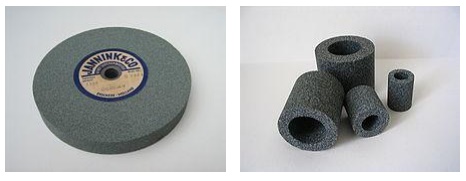Chapter: Mechanical : Manufacturing Technology : Abrasive Process and Broaching
Grinding Wheels

Grinding Wheels
A grinding wheel is an expendable
wheel that is composed of an abrasive compound used for various grinding
(abrasive cutting) and abrasive machining operations. They are used in grinding
machines.
The wheels are generally made from a matrix of coarse particles
pressed and bonded together to form a solid, circular shape. Various profiles
and cross sections are available depending on the

intended usage for
the wheel. They may also be made from a solid steel or aluminium disc with
particles bonded to the surface.
The manufacture of
these wheels is a precise and tightly controlled process, due not only to the
inherent safety risks of a spinning disc, but also the composition and
uniformity required to prevent that disc from exploding due to the high stresses
produced on rotation.
There are five
characteristics of a cutting wheel: material, grain size, wheel grade, grain
spacing, and bond type. They will be indicated by codes on the wheel's label.
Abrasive Grain, the actual abrasive, is selected according to the hardness of
the material being cut.
· Aluminum
Oxide (A)
· Silicon
Carbide (S)
· Ceramic
(C)
· Diamond
(D, MD, SD)
· Cubic
Boron Nitride (B)
Grinding wheels
with diamond or Cubic Boron Nitride (CBN) grains are called superabrasives.
Grinding wheels with Aluminum Oxide (corundum), Silicon Carbide or Ceramic
grains are called conventional abrasives.
Grain size, from 8 (coarsest) 1200 (finest), determines the physical size
of the abrasive grains in the wheel. A larger grain will cut freely, allowing
fast cutting but poor surface finish. Ultra-fine grain sizes are for precision
finish work.
Wheel grade, from A (soft) to Z (hard), determines how tightly the bond
holds the abrasive. Grade affects almost all considerations of grinding,
such as wheel speed, coolant flow, maximum and minimum feed rates, and grinding
depth.
Grain spacing, or structure, from 1 (densest) to 16 (least dense). Density is
the ratio of bond and abrasive to air space. A less-dense wheel will cut
freely, and has a large effect on surface finish. It is also able to take a
deeper or wider cut with less coolant, as the chip clearance on the wheel is
greater.
Wheel bond, how the wheel holds the abrasives, affects finish, coolant,
and minimum/maximum wheel speed.
· Vitrified (V)
· Resinoid (B)
· Silicate (S)
· Shellac (E)
· Rubber (R)
· Metal (M)
· Oxychloride (O)
Related Topics